Schooner Nina
The story of the famous Schooner Nina, and the crew of 7 who lost their lives on its final voyage

Schooner Nina and her crew
Introduction
The Schooner Niña is famous as a boat that transformed ocean racing yacht design. Prior to its construction in 1928, ocean racing was dominated by gaff-rigged ‘fisherman’ schooners, many named after their designer, John Alden. Nina was a narrower and deeper-hulled boat rigged with a Marconi main sail with staysails forward, and it signaled the future of yacht design by winning its first race (New York to Santander) followed in short order by the Fastnet race (in the Irish Sea and English Channel) – the first American yacht to do so.
But the Niña will be remembered for its final voyage, where tragically its crew of seven are presumed to have lost their lives when the Niña disappeared on a voyage from New Zealand across the Tasman Sea to Australia. The largest search in the history of RCCNZ (Rescue Coordination Centre, New Zealand), followed by months of searching organized by relatives of the crew, failed to find any trace of the vessel and crew, or any wreckage. June 4 th 2013 marks the date of this greatest loss of life in recreational boating history.
The History of Schooner Niña
Designer: W. Starling Burgess. Built by: Reuben Bigalow Ship Yard, Cape Cod, Massachusetts, USA .
Year Built: 1928 Original Owner: Paul Hammond
Burgess “Nina” Specifications: Overall length 70’0”/21.33m. Length on deck 59’0”/17.98m Water Line length 50’0″/15.24m Beam 14’10”/4.52m Draft 9’7”/2.92m. Displacement 44 tons. Sail Area: 2,275 sq ft Foremast: 65′ 0″ / 19.81m – Mainmast: 85′ 0″ / 25.90m
Race history
Known Racing History:
1928 Winner New York to Santander, Spain. 3,900 mile race in 24 days, greeted by King Alfonso from his launch, with “Well sailed, Niña, I congratulate you! I am the King of Spain.” Niña then went to England for the 600 mile Fastnet Race which takes place through the stormy waters of the English Channel and the Irish Sea. She became the first American yacht to win that race. Her overall time was 4 days, 12 hours, 48 minutes, 13 seconds. 1929 Winner London to Gibson Island Chesapeake Bay. Niña had one more major win, the 1929 race from London to Gibson Island Chesapeake Bay. She was temporarily retired as owner, Paul Hammond, became involved in the 1930 Americas Cup race.
1939 Winner New York Yacht Club Astor Cup, and 1940 Winner New York Yacht Club Astor Cup. In 1934, New York banker, DeCoursey Fales bought Niña, and each year of his life he became more and more devoted to her. He would talk for hours about the ‘old girl’. The rest of Niña’s career was probably fore-ordained as she won the New York Yacht Club Astor Cup in 1939 and 1940. Just before WWII, she won for the first time an event that was to become her specialty, the 233 mile Stanford-Vineyard Race on Long Island Sound. Afterward, she was laid up for the duration of the war. Niña was not allowed to rot, however, and she came out after the war in better shape than ever for a three year stint as flag ship for the New York Yacht Club.
1949 Winner Cygnet Cup Mr. Fales became the NYYC commodore in 1949, and Niña earned her honors by taking first place in ¾ of the yacht club’s squadron races as well as winning the Cygnet Cup in 1949. She made such a habit of winning races that Commodore Fales put the trophies back in competition. It became almost a stock joke that Niña would proceed to win back her own trophies! 1962 Winner Newport to Bermuda Race. In 1962 to thunderous cheers, Niña, became the oldest yacht at 34 years to win the Newport to Bermuda Race, under 72 year old Commodore Fales (the oldest skipper in the race!). In 1966, then 78 year old Commodore Fales passed away while his crew was attempting to repeat the Bermuda win. Niña had five owners after Fales, one being Kings Point Academy. 1989 Winner New York Mayors Cup 1994 Winner Antigua (Schooner Class) 2012 Winner New Zealand’s 37th Tall Ships and Classic Invitation
Starling Burgess NINA
Ownership and Restoration, from mid 90’s
Nina was purchased in 1988 by David N. and Rosemary Dyche. They undertook much restoration to the vessel. A new deck took 3 years to complete and was finished in 1997. Photos of some of the restoration can be seen here http://www.sail-world.com/111389 .
In September 2008, the Dyche family, including David junior, began circumnavigating.
A replacement engine was fitted and trialled in Opua, shortly before starting the fateful last voyage.
The final voyage
On 29 th May 2013, the Historic American Schooner Niña, with a crew of seven, left Opua, New Zealand on a planned voyage to Newcastle, Australia. On 4 th June 2013, contact with the vessel was lost.
This treatise documents everything known about the vessel, the crew, the journey, and the search for the vessel following loss of communication.
Leave a Reply Cancel reply
Your email address will not be published. Required fields are marked *
Save my name, email, and website in this browser for the next time I comment.
The New York Times
City room | a maritime beauty, possibly gone forever, a maritime beauty, possibly gone forever.

John Rousmaniere remembers the last time he saw Nina in top form. It was 1962, and it was dazzling its way to Bermuda, leaving a bunch of younger and sleeker challengers in its wake.
It already was a rare craft, a mahogany schooner racing across the ocean against a pack of sloops and yawls. It had been 15 years since it was the flagship of the New York Yacht Club, but the yacht was still turning heads with its sails billowing out from its wooden masts.
“It was really dramatic” to race against Nina, Mr. Rousmaniere recalled a few days ago, as news of the vessel’s disappearance spread. “It’s a tragedy that she’s been lost.”
The 70-foot schooner left New Zealand in late May, bound for the west coast of Australia with seven people aboard, including a family from Florida who had sailed it around the world for more than four years. According to the British Broadcasting Corporation , those on the yacht included the family — David Dyche, 58; his wife, Rosemary, 60; and their son David — Evi Nemeth, 73; and a Briton, Matthew Wootton, 35. A 28-year-old man and an 18-year-old woman, identified by her father as Danielle Wright, according to the Australian newspaper The Age , were also aboard.
The last known communication from Nina was on June 4 when it was caught in a severe storm. A text message released on Thursday, which had been sent by satellite phone from the vessel to a meteorologist, said, “THANKS STORM SAILS SHREDDED LAST NIGHT, NOW BARE POLES,” and indicated that information about its course would soon be updated. No such update ever came, and the BBC reported that rescuers called off the search for the yacht last week.
Aerial searches of a vast expanse of the Tasman Sea yielded no sign of the schooner or any of its passengers. Leaders of the search said they believed it sank suddenly in the storm, leaving no time for the crew to deploy lifeboats.
If Nina did sink, it would spell the end of a long, eventful life that took the yacht from its creation on Cape Cod to New York City, to Bermuda and back many times, across the Atlantic to Europe, to Florida and, finally, to the South Pacific. Along the way, it was a racer, a flagship, a training vessel for aspiring mariners and the unrequited love of so many sailors.
“She represents the end of an era,” said Nick van Nes, whose father, Hans, owned Nina for more than 15 years. “You rarely see so much love and loyalty going into a boat.”

Mr. van Nes, 68, recalled that when his father was looking for a place to keep Nina after leaving the New York area for New England, the schooner was embraced wherever he took it. “He sailed into Vineyard Haven, and the owner of the shipyard said, ‘You can dock here anytime as my guest. I’d be honored,’ ” Mr. van Nes recounted on Friday from his home on Martha’s Vineyard.
Nina was built in 1928 on Cape Cod, designed by William Starling Burgess for its first owner, Paul Hammond. The schooner immediately shocked the yachting world in July 1928 by winning a race from New York to Santander, Spain, and capturing a cup offered by the queen of Spain.
A month later, Nina won the Fastnet Race off the coast of England, and its competitive credentials were established.
In 1935, DeCoursey Fales, a banker who was a member of the New York Yacht Club, bought Nina. When Mr. Fales was elected commodore of the yacht club, whose headquarters are in a Beaux-Arts landmark building on 44th Street in Manhattan, Nina became the club’s flagship.
Mr. Fales lovingly maintained Nina and raced it aggressively, Mr. Rousmaniere, the historian of the New York Yacht Club, recalled. He kept the vessel at a boatyard at City Island, which then was a haven for racing yachts.
He made sure to keep Nina stripped down to its fighting weight.
“Day races, Bermuda races, overnight races, he kept at it,” Mr. Rousmaniere said.
By 1962, when Nina should have been well past its prime, Mr. Fales entered it in a Newport-to-Bermuda race against a pack of yawls and single-masted sloops. With the wind just right to take advantage of the schooner’s big sails, Mr. Fales sailed Nina to an unexpected victory.
“It was a very popular win because the boat was so handsome,” Mr. Rousmaniere said.
The health of Mr. Fales, who was 74 when he won the race to Bermuda, soon began to fail, but his enthusiasm for racing Nina did not. Mr. van Nes recalled seeing Mr. Fales strapped into the helm when he no longer had the strength to keep his balance on Nina. He died in 1966 while the boat was racing to Bermuda.
After his death, Nina passed from one owner to another, briefly belonging to the United States Merchant Marine Academy in Kings Point, N.Y. By 1975, the schooner had been sitting idle at a marina in Stamford, Conn., for a few years during a dispute over payment for repairs.
Mr. van Nes said he encouraged the marina’s owner to auction off Nina, because he wanted the vessel for himself. At the time, he was charging tourists and workers on Wall Street $3.75 for a 45-minute lunchtime cruise from Battery Park at the tip of Manhattan. There was so much demand for a short jaunt in the harbor, he was certain he could use another schooner there.
Mr. van Nes persuaded his father to bid up to $75,000 for Nina, promising to repay him over several years. Hans van Nes won the auction with a bid of $49,700, but Nina had the same effect on him that it had on so many other sailors.
Mr. van Nes never owned Nina because his father would not give it up. He took the schooner to Massachusetts and sailed it with a group of friends on regular trips from New Bedford to Nantucket and Martha’s Vineyard and back, Mr. van Nes said.
“He just absolutely loved the boat, and everybody he sailed with loved it, too,” Mr. van Nes said. His father eventually sold Nina to Mr. Dyche, the Florida resident who was sailing the yacht when it disappeared en route to Australia last month.
Mr. van Nes confessed that his own sentiments toward Nina were so persistent that about a week before he heard of Nina’s disappearance, he had searched online for information about its whereabouts. Wistful, he said, he found a YouTube video of the Dyche family happily sailing it across the Atlantic, bound for Ireland. The schooner was still a sight to behold.
He recalled that Olin Stephens, one of the most successful designers of racing yachts in history, once told him that Nina was the only yacht that looked great from any angle. Try as he might, Mr. Stephens told him, he had never been able to match Nina in the looks department.
“That was always a great tribute to the boat,” Mr. van Nes said.
What's Next
- Skip to main content
- Keyboard shortcuts for audio player
The Two-Way
International, florida family, historic yacht presumed lost off new zealand.
Wright Bryan

This undated photo provided by the St. Andrews Historic Seaport and Commercial Marina in Panama City, Fla., shows American David Dyche, skipper of the 70-foot (21-meter) vessel Nina. AP hide caption
This undated photo provided by the St. Andrews Historic Seaport and Commercial Marina in Panama City, Fla., shows American David Dyche, skipper of the 70-foot (21-meter) vessel Nina.
The search for six Americans and one British man lost in the seas between New Zealand and Australia was called off Friday after extensive aerial searches failed to turn up any sign of the 85-year-old wooden sailing boat they were traveling on.
Officials in New Zealand said the last known communication from the Nina's crew came on June 4 in the form of an undelivered text message stating that the boat's sails had been shredded in a storm.
Authorities now believe that the boat likely sank that day.
The Associated Press says the Americans included David Dyche, 58; his wife Rosemary, 60; their son David, 17; and their friend Evi Nemeth, 73.
A BBC report on the search described them as seasoned sailors:
"The Dyche family were said to be experienced sailors who had been sailing around the world for several years."
The passage from New Zealand to Australia was set to be the family's last big trip together before the younger Dyche headed back to the United States to start college, according to an earlier report in The Sydney Morning Herald . It also noted that their classic sailboat had "won the famous British Isles Fastnet race in 1928."
- New Zealand
- Pontoon Boats
- Personal Watercraft
- nauticalknowhow
- Nautical Knots
- Tools and Calculators
The Niña, the Pinta and the Santa Maria
Most schoolchildren learn the tale of Christopher Columbus and his historic voyage across the ocean. The story has evolved over time to take a more realistic and practical view of the trip. Gone are they days when people thought Columbus thought the world was flat. But there’s one part of the story that not enough people pay attention to and that’s the ships themselves. Just how did Columbus make the journey that only a handful of Vikings had ever made before?
When Columbus Sailed for the Americas
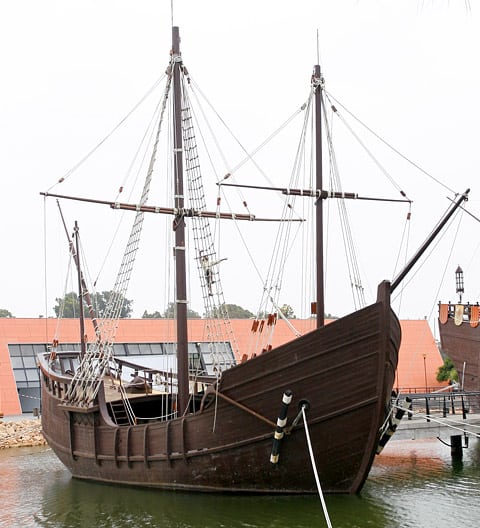
Keep in mind, the popular story many people hear was that either Columbus thought the world was flat or that he thought he found China. Neither of these are true. The reason Columbus headed West was because everyone knew the world was round. The problem was he thought it was a lot smaller than it truly is and that it would be a shortcut to China and India. He realized right away that they hadn’t found the Orient. They found a new land that no one had expected to be there.
The Story of Christopher Columbus’ Ships
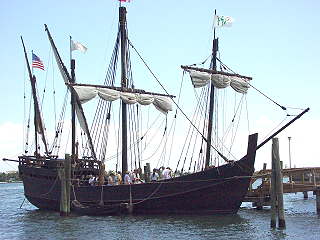
The flagship Santa Maria was a carrack that displaced about 100 tons. It had a single deck and three masts. The Nina and the Pinta were known as caravel vessels. Each ship carried supplies for their crews. Food, animals, water and so on. Sleeping quarters were not included, the crew would have slept on the deck.
None of the three ships were ever explicitly intended for exploration. Each was likely a second hand merchant ship, the best that could be obtained at the time to be fast enough and reliable enough to do the job.
The smaller caravels were very popular in Columbus’ day, the sports cars of the sea. Sleek and fast, they were skilling at sailing upwind . They made use of lateen sails which greatly helped their performance. A lateen sail is basically a triangular sail set at a 45 degree angle to the deck.
Both of the caravels were lightweight and rode high in the water. Part of the reason was, of course, that they were so light on crew as well. There were 20 men on the Nina and 26 on the Pinta.
As we all know, the ships were the Nina, the Pinta and the Santa Maria. So what were the Santa Clara and the Santa Gallega?
Santa Gallega or La Gallega was the name of the Santa Maria before Columbus’s voyage. Columbus never actually
recorded the name of the Santa Maria in his writing, only the names of the other two vessels. It’s believed by some that he obtained the Gallega and changed the name himself. Some think the Gallega, which means Galician, indicates the ship was built in Galicia in Spain.
As for the Santa Clara, that was the true name of the Nina. Saint Clare of Assisi, also known as Santa Clara, was the patron saint of good weather, among many other things. The Nina was a nickname, and it was not uncommon for Spanish vessels to follow this system. One formal name, in particular that of a saint, and a more common name that was more in line with the crews vernacular.
What We Know Today
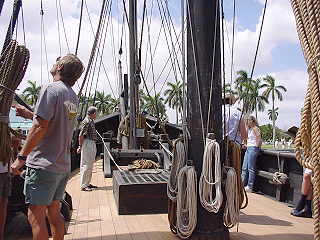
We don’t have the ships to look at any longer, just similar examples. None of them survived. Most people believe the vessels had three masts but it’s possible the Nina had four masts. This includes a small counter-mizzen. We know that the Nina was also refitted with square sails in the Canary Islands. Based on similar vessels we do have descriptions of, and descriptions the crews gave, some replicas have been produced.
The vessels were much different than anything you’d find today. The layout, design and function was unusual by our standards. For instance, few if any crew members were able to read or write. That meant keeping a log of what happened on a given shift was all but impossible. Instead, the crew used a peg board system to indicate things like wind direction, estimated speed, and bearing.
Piloting the ship was unusual as well. From the tiller, you would be unable to see where you were going. As such, another crew member needed to be positioned at the bow or in the crow’s nest as a lookout. They would relay messages to the one operating the tiller if any course corrections were needed.
A watch shift would last for four hours. An hour glass was used to mark the time. Another crew member, the youngest on board, would be tasked with watching the glass. He’d call it out when it was done, and then turn the glass to start it again.
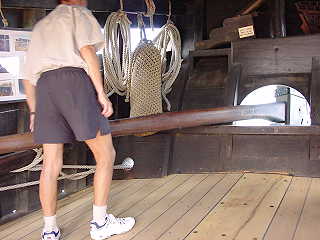
There have been more models made of the Santa Maria than the other ships. Again, no accurate figures exist to determine the exact dimensions of the original, however. That means every replica is a “best guess” or artistic interpretation of what the historic vessel looked like.
Back in 1892, the Spanish government commissioned a replica for the 400th anniversary of the voyage. Columbus, Ohio built their own for the 500th anniversary in 1992. This was declared by historians to be an extremely accurate replica. There was even one built in Canada to be used in the West Edmonton Mall back in the 1980s.
About Chris
Outdoors, I’m in my element, especially in the water. I know the importance of being geared up for anything. I do the deep digital dive, researching gear, boats and knowhow and love keeping my readership at the helm of their passions.
Categories : Boats
Leave a Reply Cancel reply
Your email address will not be published. Required fields are marked *
Save my name, email, and website in this browser for the next time I comment.
More in Boats

What Is A Gunwale?

131 of the Best Hawaiian Boat Names

167 Patriotic Boat Names

The 138 Best Boat Names for Dog Lovers

The People’s Poncho Review and Ratings

Oru Lake Kayak Review

About Boatsafe
Established in 1998, BoatSafe is your independent guide into the world of boating, fishing, and watersports. We provide expert insights and detailed guides to help you find products tailored to your needs and budget.
Contact Boatsafe
- Address: 4021 West Walnut Street. Rogers, AR 72756
- Phone: (479)339-4795
- Email: [email protected]
Site Navigation
- How We Test
- Corrections Policy
- Privacy Policy
- Terms & Conditions
- Editorial Policy
- Affiliate Disclosure
Our Reviews

All content is © Copyright 2024. All rights reserved.
- Subscribe Now
- Digital Editions
Capsize survivor urges continued search for missing yacht Nina
- Isobel Smith
A man who spent 119 days lost at sea is urging authorities in New Zealand to continue the search for missing yacht Nina

Sailor John Glennie has urged authorities to continue the search for the missing schooner Nina after he survived 119 days lost at sea. Mr Glennie has written to the Rescue Co-ordination Centre (RCC) and told of how him and three other crew members were left fighting for their lives after their trimaran Rose Noelle capsized in the Pacific Ocean in 1989. Now he has joined the families of Nina crew members, calling on the rescue agency to resume the search. The 21m schooner and its seven crew left the Bay of Islands on May 29 and last made contact in June, when a text message was sent asking for a weather update. While the official search for Nina has now ended, family members organised another search, which produced a satellite image that is thought to be the missing schooner. “If the image of the boat … is the Nina … then in my humble opinion there is every chance the crew will be in fine shape,” Mr Glennie wrote.
“I know we could have been out there another six months on an upside down Rose Noelle , in which case an upright Nina will have no worries.”
The image appeared to show a water catchment system rigged up from a sail, which did not surprise him because Nina had a “great crew”.
The New Zealand Herald has obtained letters from family members of the missing crew, in which they describe their determination to find their loved ones.
Crew member Kyle Jackson’s family said they desperately wanted to be reunited with their son, but needed the RCC to act.
“They are survivors and they can survive this, they just need your help finding their way home.”
RCC Safety and Response Services general manager Nigel Clifford told the New Zealand Herald that the images weren’t “sufficiently compelling to go out with an airplane to go look for something … [due to] the quality of the picture.
“It’s extremely unlikely to be the Nina – you can’t say that it’s not, you can’t be 100 per cent sure – but the analysis is that it’s extremely unlikely.”
Related articles
- New satellite images may having missing schooner
- Image of missing sailor’s yacht released
- Search for missing sailor stood down

- CLASSIFIEDS
- NEWSLETTERS
- SUBMIT NEWS

Revealing report on Search for American yacht Nina released
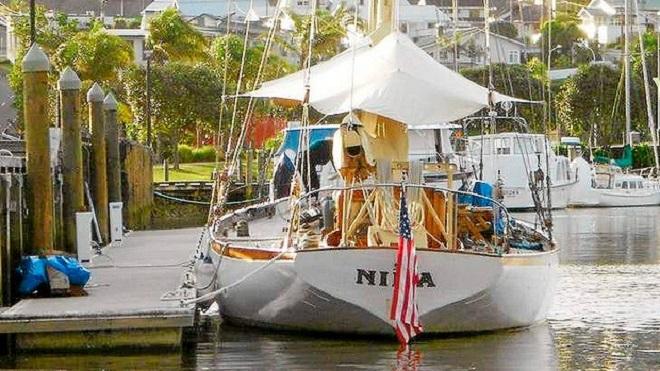
Related Articles


Historic Racing Sailboat Nina Missing
Published on June 27th, 2013 by Slade -->
The former Bermuda Race winner and legendary yacht Nina and its crew of seven, including six Americans, has gone missing. A wooden schooner built in 1928, the Nina, left port in northern New Zealand at the end of May and dropped out of communication a week later. It was en route to Newcastle, Australia. The sailing yacht is equipped with a tracking device, a satellite phone and an emergency buoy, but none of them have been heard from since early June, according to Maritime New Zealand, when the Nina was nearly 400 miles northwest of New Zealand in the Tasman Sea. Read story

Tags: Sailing Yacht Nina
Related Posts
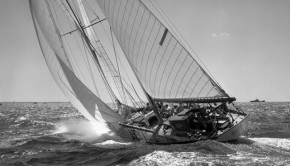
Capsize survivor urges to continue search for Nina →
Classic yacht long overdue →.
© 2024 Scuttlebutt Sailing News. Inbox Communications, Inc. All Rights Reserved. made by VSSL Agency .
- Privacy Statement
- Advertise With Us
Get Your Sailing News Fix!
Your download by email.
- Your Name...
- Your Email... *
- Name This field is for validation purposes and should be left unchanged.

- The Dyche Family
Kyle Jackson
- Matthew Wootton
Danielle Wright
- General Monthly Updates
- Families’ Response to Review
- SAR Lessons
- Search Support
- Official Communications
- Maps of Aircraft Search Tracks
- Objects of Interest
- Wind Models
- Drift Models
- Satellite Image Information
The Nina families still not given up hope (Radio New Zealand)
Sue is interviewed by Radio New Zealand: http://www.radionz.co.nz/audio/player/2584518
Lost at Sea (The Sydney Morning Herald)
The schooner Niña disappeared during a storm in the Tasman Sea last June. Frank Robson meets the parents of one of the missing crew, who continue to search for their daughter. Read more: http://www.smh.com.au/national/lost-at-sea-20140205-32039.html#ixzz2t3qL9yK1
An update from Robin Wright
A message from Robin Wright: Ricky and I are wrapping up our visit to Australia and New Zealand in the next 2 weeks. It’s hard to even think about coming home without Danielle, but we’ve done everything we know to do to search for Nina and 7 very special people. We know they can survive …
Niña Crew Not Ready to Give Up
TV New Zealand news story. Update on how we are continuing the search effort and looking for answers from Officials. http://tvnz.co.nz/national-news/family-missing-nina-crew-not-ready-give-up-5816913/video Message from Robin Wright: Thank you Jehan Casinader and Lee Frashier for covering our story and for taking us to Whangarei and Opua. It was a little disappointing that the broadcast seemed to suggest …
Search Continues for American Schooner Missing at Sea Since June (People Magazine)
Search Continues for American Schooner Missing at Sea Since June http://www.people.com/people/article/0,,20777101,00.html
The Niña Seven
The lives of 7 people are at risk. The sailing schooner, Niña, went missing in the Tasman Sea, and the families of the crew have requested help from the U.S. Department of State and New Zealand rescue authorities, as we believe the sailors are trapped on the disabled Niña.
Rosemary, David III, and David IV on the deck of the Niña.
The Recovery Coordination Centre in New Zealand (RCCNZ) was contacted on June 8 and asked to help. RCCNZ did conduct 6-days of aerial searches beginning June 25th – 3 weeks after the Niña last communications. The RCCNZ search stopped July 4th and declared the Niña had sunk and the crew dead.
The five families of the crew did not accept that conclusion:
“I know my daughter is alive and waiting to be rescued” – Ricky & Robin Wright, parents of 19-year old Danielle Wright, Niña Crew Member
“matthew is strong and a survivalist and we know he is still aboard the niña and trying to make his way home”, – sue & ian wootton, parents of matthew wootton, niña crew member.
On July 18th the families contacted Texas Equusearch Search and Recovery (TES), a non-profit volunteer service organization dedicated to assisting families find and return lost love ones (www.txeq.org) and asked for help in finding the Niña and her crew. TES formed a small core team of technology specialists and work began work creating a search and rescue plan.
Efforts to get U.S, New Zealand, and Australian support failed, leaving the families and TES completely on their own. However, money was raised, 100s of volunteers were recruited, and search efforts began. Experienced search and recovery flight crews were hired and have flown over 100 missions near New Zealand, Lord Howe Island, Norfolk Island and Australia.
Needing wider range coverage, TES was successful in bringing on DigitalGlobe and its subsidiary Tomnod, who have graciously supplied free-of-charge high resolution satellite images. The process is to review the satellite images via the Internet, and when an object of interest is identified, send a search plane out to look for it. However, this resource has also failed to accurately locate the missing Niña.
Funds are very limited since they come from private donations and are used to pay for the aerial searches, drift modeling, and other activities to keep this search going. But the bottom line is from hundreds of hours of hard work, the Niña has not been found and our continued hope is she will be seen by passing ships or planes, or run aground on many of the coastal islands in the area and be rescued.
How can you help?
Donate Sign the Petition
Like us on Facebook to get the latest info & to know if/when new satellite images are posted and other updates for how you can help find the Niña.
- Air Search (4)
- General Monthly Updates (2)
- Satellite Image Search (2)
- Updates (13)
© 2024 TES S/V Schooner Nina Search.
- Return to top
Powered by WordPress and the Graphene Theme .

Incredible moment two exhausted sailors are plucked from the raging South Atlantic 1,450 miles from land after their hero Swiss captain made sure they were safely inside a life raft before going down with his ship
- Captain Benno Frey died saving his fellow crew mates
- The two men he saved were adrift for hours before they were picked up
- They are said to be incredibly distressed over Frey's passing
The heroic skipper of an ocean-going yacht went down with his vessel in a violent storm after first making sure his two crewmen were safely inside their emergency life raft.
Captain Benno Frey, 72, ran into a tempest with 60mph winds and 25ft-tall waves which battered his 54ft-long boat until it began taking on seawater and started sinking quickly on March 14.
His modern yacht should have weathered the strong storm but it is believed to have struck a container washed off a cargo ship, which left a hole below the water line.
Benno, a Swiss national, and his crew members Brazilian Marcelo Osanai, 38, and American-Swiss national Balthasar Wyss, 52, desperately tried to keep it afloat.
But just after midnight, father-of-two Benno realised their situation was critical and set off an international distress Mayday alert that they were going down fast.
The trio stayed on board the stricken Nina Pope for a short time, until in an act of selfless heroism Benno launched the crew rescue life raft in darkness into the ocean.
He ordered Marcelo and Balthasar to unclip their safety lines and handed them a £350 tiny handheld Garmin satellite SOS transmitter and get in.
But before Benno could unclip his safety line and join them the boat suddenly went down taking him with it and his last action was to cast the inflatable raft with his crew on it free.
Their desperate SOS was picked up by the Maritime Safety Authority South Africa in Cape Town, 1450 miles east of their location which was the nearest landfall to the terrified shipwrecked survivors.
Adrift in mountainous seas sealed in the life raft Marcelo and Balthasar were at the mercy of the Atlantic as the high winds and crashing waves threatened to capsize them.
But unknown to them the MSASA in Cape Town had relayed their distress Mayday to the nearby giant super tanker Front Pollux which had diverted course for a daring rescue.
And in this incredible mobile phone footage shot from the deck of the 825 feet long crude oil carrier the vulnerable eight-foot by eight-foot life raft is seen located in heavy seas.
The thankful survivors feared the worst saying later that they felt finding them would be like 'finding a needle in a haystack' and that they owed their lives to the tiny £350 gadget.
The Garmin hand held satellite transmitter - less than the size of a packet of cigarettes - had been beaming out a signal that guided the 62,000 ton tanker to their exact position.
Both sailors can be seen looking out of their rescue inflatable up at the crew far above who had positioned their tanker to take the brunt of the storm and protect them in the lee.
The Front Pollux dropped a steel walkway half way down their vast hull then a crew member went down and dropped a rope ladder from that into the ocean for the survivors to grab.
The two thankful sailors who had paid to sail on the Nina Pope the 3600 miles from Rio de Janeiro, Brazil, to Cape Town, South Africa, grabbed the lifeline knowing they were safe.
Despite being in the lee of the tanker now in calmer waters the exhausted sailors can be seen using the last of their energy climbing up the wooden slats of the 50ft swinging ladder.
Once on board the super tanker they were given warm clothing and hot drinks and medically examined but apart from exhaustion and shock were both otherwise uninjured.
Both of the rescued businessman who had taken sabbaticals from their high-powered jobs to fulfil a sailing dream are said to be 'highly distressed' at losing Benno.
A source on the Front Pollux said: 'They saw the skipper Benno go down. It seems he could not get his safety line undone in time as the yacht went down very quickly.
'If he had not cast the life raft adrift immediately it would have been dragged down to the bottom with the Nina Pope. Both the survivors have been finding it very hard to take in.
'The South Atlantic is vast and in stormy seas with an 8m swell it is almost impossilbe to spot a tiny life raft but the SOS transmitter they had was what saved both their lives.
'We had the signal and just had to follow it until we got in the vicinity and slowed the engines and scoured the area with binoculars until someone on the bridge spotted it.
'That little bit of kit made all the difference out there' he said.
Benno's distraught ex-wife Beatrice, 60, from Roggwill in Switzerland said: 'Although we parted after 11 years of marriage in 2019 we were still the very best of friends.
'Benno had been sailing for 50 years and in 2000 he got his International Skippers Licence and had always wanted to sail the world and with his retirement his dream came true.
'Benno lived his days on his beloved Nina Pope sailing the world and was living his dream. He was a very good man and had so many friends in every port he called in.
'His children Tamara, 43, and Joel, 40, are as you can imagine taking it very badly. I have spoken to his crew but they are too upset to go into the full detail of exactly what happened.
'It is a very difficult time for us all right now' said food and nutrition expert Beatrice at her home in the Canton of Bern.
Benno's two children are from a previous marriage and had both sailed with him many times.
Peter Millington who runs a news website on the British island colony of Tristan da Cunha revealed his friend Benno had called in twice whilst sailing across the South Atlantic.
Peter said: 'We are a stopping off point between Brazil and Cape Town and Benno anchored on Monday last week and came on shore to get water and provisions.
'We have a photo of him and Marcelo and Balthasar having a lunch here of lobster tails and potatoes with salad and they were using the wifi to talk to their friends and family.
'Benno understood a storm was coming in but the harbour here is very small and not suitable for yachts and it is too dangerous to try and ride out a storm at anchor.
'It was not the biggest of storms and Benno decided the safest way forward was to set sail and the three of them were waved off in their tender and we took a pic of them sailing away.
'Tragically less than 48 hours later the Nina Pope and Benno were lost to the sea. His wife Beatrice emailed the island to ask if any of our boats could offer help in a rescue.
'Unfortunately our fishing boats are inshore vessels and it was too far away. I saw the Mayday and followed the rescue and saw the Nina Pope's signal disappear later on Wednesdy.
'I feared the worst that she had sunk and sadly I was proved correct' he said.
The Nina Pope had sailed 140 miles from Tristan da Cunha before she hit the container and was still 1450 miles from Cape Town when the crew abandoned ship into the Atlantic.
The Nina Pope had set off on February 27 for the three-week crossing with digital commerce expert Marcelo from Rio de Janeiro and hi-tech expert Balthasar as paying crew.
Married dad Balthasar who was originally from Basel, Switzerland, and now lives in Seattle, USA, had been advertising on Facebook to pay to crew on a yacht trip.
He said on it: 'After 30 years of business (hi-tech) I would like to make my dream of crossing oceans and exploring remote places a reality on a sabbatical from work.
'I have basic sailing experience and I am very interested in everything about sailing and navigation as I am considering buying my own sailing boat in the future.
'I will pay my expenses and a contribution to the cost of sailing and do the chores!'.
A spokesman for the South African Maritime Safety Authority said: 'After midnight last Wednesday a Swiss flagged sailing vessel the Nina Pope reported taking on water.
'They had activated their emergency beacon close to the rescue point border of Uruguay and South Africa but we agreed to take on the search and co-ordinate rescue efforts.
'The tanker Front Pollux diverted to the Mayday beacon and later Wednesday it reported finding the lift raft then signs of life in the raft and recovered two surviving crew members.
'The Front Pollux reported that the skipper was lost at sea when the Nina Pope sunk and further reported they would be returning the two surviving crew to Cape Town.
'SAMSA convey their deepest condolences to the family and friends of the deceased.
'We also express our heartfelt gratitude to all Search & Rescue partners especially the crew of the Front Pollux for their valiant efforts in the very difficult rescue operation' they said.
The Front Pollux anchored off Cape Town on Monday and the two survivors were transferred by the NSRI lifeboat to the shore where he MSASA greeted them.
Both sailors lost all their possessions on the yacht and emergency documents are being prepared by their embassies so they can return home to Brazil and the USA.
They declined to requests to be interviewed by the media.
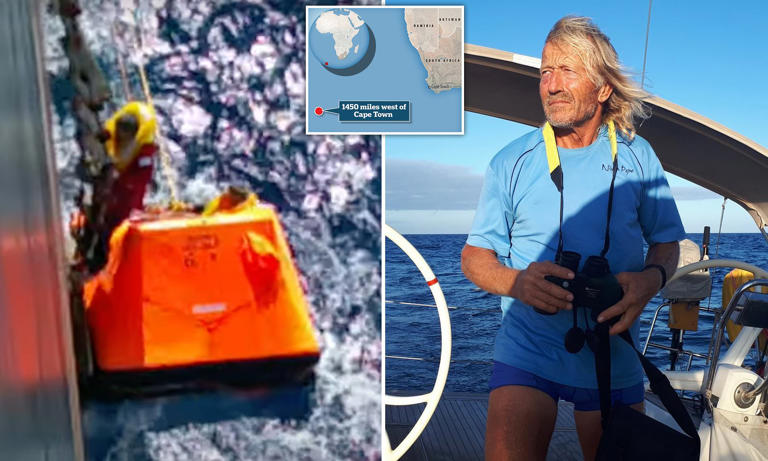

- CLASSIFIEDS
- NEWSLETTERS
- SUBMIT NEWS

New thread of hope - is this a photo of drifting Nina?


Related Articles

Sea warnings
Search this blog, distress call: yacht nina pope in need of assistance.
Update 2024-03-14 17:54:34 UTC :
Update 2024-03-15 :
It has only just been learned that there were 3 crew members. Two were rescued but a third has died.

Issued: March 14, 2024, at 07:18 UTC
Source: Cape Town Radio via Inmarsat
Urgency: Distress - REASON FOR DISTRESS IS FLOODING AND SINKING.

- An undesignated Garmin SOS distress signal was received by Cape Town Radio.
- The vessel in distress has been identified as the yacht "Nina Pope."
- Location: 37° 55' 18.7" South, 7° 31' 04.4" West (South Atlantic Ocean)
Request for Assistance:
All vessels transiting near the reported location are urged to divert and render assistance to the yacht Nina Pope if possible.
Any sightings of the Nina Pope or information regarding its condition should be reported immediately to Cape Town Radio or MRCC Cape Town.
Weather conditions:

- Overcast skies: The sky is completely covered with clouds, indicating a lack of sunlight and potentially gloomy weather conditions.
- Wind speed: 33 knots: This is a relatively strong wind, capable of causing significant wave action and making sailing or other water activities challenging.
- Gusts to 37 knots: These brief, intense bursts of wind can be even more disruptive than the sustained wind speed, and mariners should be prepared for sudden changes in wind conditions.
- Seas: 19 feet: These waves are considered to be "moderate" in size, and can be hazardous to small craft. Larger vessels may experience some discomfort but should be able to operate safely.

Post a Comment
Popular posts from this blog, distress call issued for missing sailing yacht "ilan7" in ionian sea, distress call issued for missing sloop in tyrrhenian sea.
- History Classics
- Your Profile
- Find History on Facebook (Opens in a new window)
- Find History on Twitter (Opens in a new window)
- Find History on YouTube (Opens in a new window)
- Find History on Instagram (Opens in a new window)
- Find History on TikTok (Opens in a new window)
- This Day In History
- History Podcasts
- History Vault
The Ships of Christopher Columbus Were Sleek, Fast—and Cramped
By: Dave Roos
Updated: July 28, 2023 | Original: October 9, 2019

On August 3, 1492, Christopher Columbus and his crew set sail from the port of Palos in southern Spain on three vessels: la Santa Clara (Niña), la Pinta and la Santa Gallega (Santa Maria). Two of the ships, the Niña and Pinta, were tiny by today’s standards—only 50 to 70 feet from bow to stern—but prized for their speed and maneuverability. The Santa Maria, Columbus’s flagship, was a larger, heavier cargo ship.
For 35 days, Columbus and his crew of 86 Spanish sailors sailed westward searching for a passage to China and India. With the men close to mutiny against their “foreign” captain, Columbus was about to turn back when the cry went out at 2 a.m. on October 12 that land had been sighted .
Columbus hadn’t found a western route to India, of course, but his success in crossing the Atlantic was due in large part to the ships he chose for the perilous voyage, particularly the diminutive Niña and Pinta, which were a speedy type of ship called a caravel.
When the royal decree went out in 1492 from Queen Isabella of Spain to fund Columbus’s first voyage, it read , “By these presents, we dispatch the noble man Christoforus Colón with three equipped caravels over the Ocean Seas toward the regions of India for certain reasons and purposes.”

Caravels Were Cutting Edge in the 15th Century
Though only two of Columbus’s ships ended up being caravels, Isabella’s decree speaks to the popularity of the vessel during the 15th-century “ Age of Discovery .” Starting with Portuguese explorations of the African coast in the mid-1400s, caravels were prized for their sleek, lightweight hull and their uncanny ability to sail into the wind.
Luis Filipe Viera de Castro, a nautical archeologist at Texas A&M University, says that the earlier Portuguese caravels, known as the caravela latina , were rigged with lateen (triangular) sails that hung at 45-degree angle to the deck.
“Lateen sails are […] almost like wings,” says Castro. “You can point the bow of the caravel with an angle of just 20 degrees off the wind and still get enough lift on the outer edge of the sail to propel forward.”
The lateen-rigged caravels were critical in the Portuguese voyages to sub-Saharan African, where strong coastal winds blow north to south. The versatile caravel could speed south along the coast and easily return to shore against the wind.
For Columbus’s maiden journey, he used a Spanish update to the caravel known as the caravela redonda , a three-masted ship where the first two masts were rigged with conventional square sails for open-ocean speed, and a third was rigged with a lateen sail for coastal maneuverability. That rigging combination made ships like the Niña and the Pinta some of the best sailing vessels of their time.
In addition to their versatile rigging options, 15th-century caravels moved the rudder to the rear center of the ship. In the 14th-century caravels popular in the Mediterranean, the rudder was still on the side, says Castro, like Viking ships. The new position allowed for far greater control.
Small Ships Offered Advantages—But Also Discomforts
Small caravels like the Niña and Pinta could only carry between 40 and 50 tons and were crewed by fewer than 30 sailors each. Their lightweight design and rounded bottom meant that they rode high in the water. This proved critical when Columbus needed to navigate the shallow island coastlines near modern-day Cuba.
The bulkier Santa Maria, which was a 110-ton cargo ship called a nau , ran aground on Christmas Day 1492 and had to be abandoned.
Yet the main advantage of the Spanish caravel, namely its compact size, was also its greatest disadvantage. Life aboard a short ship like the Niña or Pinta would have been absurdly crowded and uncomfortable.
Unlike the Santa Maria, which at least had tiny cabins where sailors could sleep between eight-hour shifts, the Niña and Pinta had a single small deck at the rear of the ship with only one cramped cabin reserved for the captain.
“If you’re a sailor on a caravel, you’re living on the deck and sleeping on the deck,” says Marc Nucup, public historian at The Mariners’ Museum in Newport News, Virginia. “You’re trying to stay out of the way of the sailors who are working. There’s almost no private space.”
Work was relentless on any 15th-century ship. The 20 sailors on the Niña and the 26 crewing the Pinta would have been constantly engaged with adjusting the rigging, trimming the sails, inspecting for leaks and plugging them with spongy scraps of old rope called oakum.
“Cathedrals, castles and ships—those were the most complicated things that humans had built up until that time,” says Nucup. “There was always something to do.”
The round-the-clock workload meant that even if you were off-duty, good luck trying to sleep on the deck while the other sailors stomped around you. Hammocks weren’t yet in use on ships in the 15th century, says Nucup.

Food Aboard Ships Was Dry and Often Filled With Maggots
And then there was the food. Columbus stocked a full year’s worth of food for the journey, not knowing how long it would be before they could return to Spain. For food to last at sea, it needed to be dry. Staples included dried and salted anchovies and cod, pickled or salted beef and pork, dried grains like chickpeas, lentils and beans, and, of course, hardtack biscuits.
The word biscuit comes from the Latin bis coctus for “twice-baked.” The hardtack biscuits “enjoyed” by Columbus’s crew would have been prepared by baking a hockey puck of flour and water multiple times, then crushing it into tiny pieces, reconstituting it with water and baking it again. Hardtack biscuits were so rock solid that they could only be eaten if softened with water or dipped in the communal slurry served every meal in a large wooden trough.
Yet tooth-breaking, dry biscuits were still preferable to those that had been spoiled by exposure to water in their storage barrel. Ferdinand Columbus, the explorer’s 14-year-old son, reported on the conditions on Columbus’s fourth voyage to the Americas.
"What with the heat and dampness, our ship biscuit had become so wormy that, God help me, I saw many who waited for darkness to eat porridge made of it, that they might not see the maggots,” wrote young Ferdinand, “and others were so used to eating them that they didn't even trouble to pick them out because they might lose their supper had they been so fastidious."

HISTORY Vault: Columbus the Lost Voyage
Ten years after his 1492 voyage, Columbus, awaiting the gallows on criminal charges in a Caribbean prison, plotted a treacherous final voyage to restore his reputation.

Sign up for Inside History
Get HISTORY’s most fascinating stories delivered to your inbox three times a week.
By submitting your information, you agree to receive emails from HISTORY and A+E Networks. You can opt out at any time. You must be 16 years or older and a resident of the United States.
More details : Privacy Notice | Terms of Use | Contact Us

CAPE TOWN FOR CAPETONIANS

Skipper presumed dead after vessel capsizes en route to Cape Town
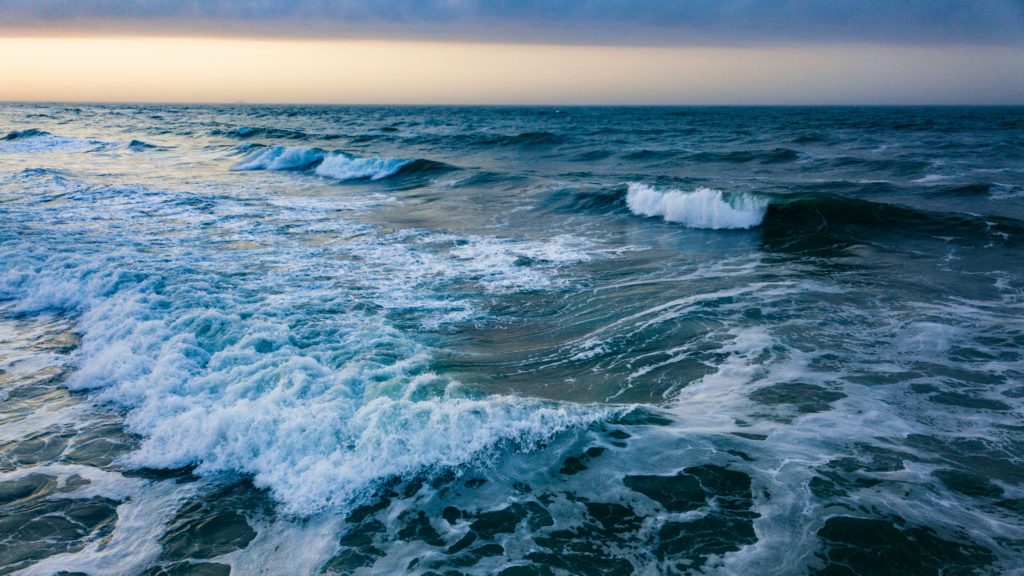
The skipper of the NINA POPE sailing vessel, which sank in the Atlantic Ocean while en route from Tristan da Cunha to Cape Town on Wednesday, is presumed dead, according to the SA Maritime Safety Authority.
Also read: NSRI rescues solo sailor from yacht near Yzerfontein
It stated that in the early hours of Wednesday morning, the Maritime Rescue Coordination Centre (MRCC) in Cape Town received an SOS Alert from the Garmin International Rescue Coordination Centre regarding the Swiss-flagged sailing vessel.
The alert indicated that the vessel was taking on water about 2400 kilometres west-southwest of Cape Town.
In a joint operation involving MRCC Uruguay and other international partners, a motor tanker was dispatched to the location.
Speaking to News24 , Samsa spokesperson Tebogo Ramatjie said that despite challenging conditions, with winds up to 74km/h and sea swells of up to eight meters, the FRONT POLLUX [motor tanker] managed to recover two male survivors from a life raft near the reported position.
Cape {town} Etc discount: Appreciate the beauty of Cape Town with a 60-minute cruise for R155 (valued at R310). Get it here . if(window.isMobile != null || window.isTablet != null){ document.write(' '); document.write(' '); googletag.cmd.push(function() { googletag.display('dfp-300x250-3'); }); document.write(' '); }
The skipper, a German national, was unable to be rescued and is believed to have perished with the vessel.
One survivor is Brazilian, while the other has dual citizenship in the United States and Switzerland.
Ramatjie stated that they were unharmed, did not require medical attention, and were expected to arrive in Cape Town next week.
Samsa extended condolences to the families of the deceased.
‘SAMSA extends its deepest condolences to the family and friends of the deceased. We also express our heartfelt gratitude to all SAR partners, especially the crew of the FRONT POLLUX, for their valiant efforts in the rescue operation,’ it said.
Explore Cape Town and its surroundings with these incredible deals on cars for under R100 000. Find car listings here .
NSRI spots vessel in distress during Cape Town Cycle Tour
Picture: Aaron Burden /Unsplash
Article written by Murray Swart
2024 elections.

CapeTownETC
Subscribe to our Newsletter cheap cars for sale cheap cars for sale in western cape cheap cars for sale in cape town Joburg news News in Johannesburg Bikes for sale

- Alzheimer's disease & dementia
- Arthritis & Rheumatism
- Attention deficit disorders
- Autism spectrum disorders
- Biomedical technology
- Diseases, Conditions, Syndromes
- Endocrinology & Metabolism
- Gastroenterology
- Gerontology & Geriatrics
- Health informatics
- Inflammatory disorders
- Medical economics
- Medical research
- Medications
- Neuroscience
- Obstetrics & gynaecology
- Oncology & Cancer
- Ophthalmology
- Overweight & Obesity
- Parkinson's & Movement disorders
- Psychology & Psychiatry
- Radiology & Imaging
- Sleep disorders
- Sports medicine & Kinesiology
- Vaccination
- Breast cancer
- Cardiovascular disease
- Chronic obstructive pulmonary disease
- Colon cancer
- Coronary artery disease
- Heart attack
- Heart disease
- High blood pressure
- Kidney disease
- Lung cancer
- Multiple sclerosis
- Myocardial infarction
- Ovarian cancer
- Post traumatic stress disorder
- Rheumatoid arthritis
- Schizophrenia
- Skin cancer
- Type 2 diabetes
- Full List »
share this!
June 4, 2024
This article has been reviewed according to Science X's editorial process and policies . Editors have highlighted the following attributes while ensuring the content's credibility:
fact-checked
reputable news agency
He fell ill on a cruise: Before he boarded the rescue boat, they handed him the bill
by Bram Sable-Smith, KFF Health News

Vincent Wasney and his fiancée, Sarah Eberlein, had never visited the ocean. They'd never even been on a plane. But when they bought their first home in Saginaw, Michigan, in 2018, their real estate agent gifted them tickets for a Royal Caribbean cruise.
After two years of delays due to the coronavirus pandemic, they set sail in December 2022.
The couple chose a cruise destined for the Bahamas in part because it included a trip to CocoCay, a private island accessible to Royal Caribbean passengers that featured a water park, balloon rides and an excursion swimming with pigs.
It was on that day on CocoCay when Wasney, 31, started feeling off, he said.
The next morning, as the couple made plans in their cabin for the last full day of the trip, Wasney made a pained noise. Eberlein saw him having a seizure in bed, with blood coming out of his mouth from biting his tongue. She opened their door to find help and happened upon another guest, who roused his wife, an emergency room physician.
Wasney was able to climb into a wheelchair brought by the ship's medical crew to take him down to the medical facility, where he was given anticonvulsants and fluids and monitored before being released.
Wasney had had seizures in the past, starting about 10 years ago, but it had been a while since his last one. Imaging back then showed no tumors, and doctors concluded he was likely epileptic, he said. He took medicine initially, but after two years without another seizure, he said, his doctors took him off the medicine to avoid liver damage.
Wasney had a second seizure on the ship a few hours later, back in his cabin. This time he stopped breathing, and Eberlein remembered his lips being so purple, they almost looked black. Again, she ran to find help but, in her haste, locked herself out. By the time the ship's medical team got into the cabin, Wasney was breathing again but had broken blood vessels along his chest and neck that he later said resembled tiger stripes.
Wasney was in the ship's medical center when he had a third seizure—a grand mal, which typically causes a loss of consciousness and violent muscle contractions. By then, the ship was close enough to port that Wasney could be evacuated by rescue boat. He was put on a stretcher to be lowered by ropes off the side of the ship, with Eberlein climbing down a rope ladder to join him.
But before they disembarked, the bill came.
The Patient: Vincent Wasney, 31, who was uninsured at the time.
Medical Services: General and enhanced observation, a blood test, anticonvulsant medicine, and a fee for services performed outside the medical facility.
Service Provider: Independence of the Seas Medical Center, the on-ship medical facility on the cruise ship operated by Royal Caribbean International.
Total Bill: $2,500.22.
What Gives: As part of Royal Caribbean's guest terms, cruise passengers "agree to pay in full" all expenses incurred on board by the end of the cruise, including those related to medical care. In addition, Royal Caribbean does not accept "land-based" health insurance plans.
Wasney said he was surprised to learn that, along with other charges like wireless internet, Royal Caribbean required him to pay his medical bills before exiting the ship—even though he was being evacuated urgently.
"Are we being held hostage at this point?" Eberlein remembered asking. "Because, obviously, if he's had three seizures in 10 hours, it's an issue."
Wasney said he has little memory of being on the ship after his first seizure—seizures often leave victims groggy and disoriented for a few hours afterward.
But he certainly remembers being shown a bill, the bulk of which was the $2,500.22 in medical charges, while waiting for the rescue boat.
Still groggy, Wasney recalled saying he couldn't afford that and a cruise employee responding, "How much can you pay?"
They drained their bank accounts , including money saved for their next house payment, and maxed out Wasney's credit card but were still about $1,000 short, he said.
Ultimately, they were allowed to leave the ship. He later learned his card was overdrafted to cover the shortfall, he said.
Royal Caribbean International did not respond to multiple inquiries from KFF Health News.
Once on land, in Florida, Wasney was taken by ambulance to the emergency room at Broward Health Medical Center in Fort Lauderdale, where he incurred thousands of dollars more in medical expenses.
He still isn't entirely sure what caused the seizures.
On the ship he was told it could have been extreme dehydration—and he said he does remember being extra thirsty on CocoCay. He also has mused whether trying escargot for the first time the night before could have played a role. Eberlein's mother is convinced the episode was connected to swimming with pigs, he said. And not to be discounted, Eberlein accidentally broke a pocket mirror three days before their trip.
Wasney, who works in a stone shop, was uninsured when they set sail. He said that one month before they embarked on their voyage, he finally felt he could afford the health plan offered through his employer and signed up, but the plan didn't start until January 2023, after their return.
They also lacked travel insurance. As inexperienced travelers, Wasney said, they thought it was for lost luggage and canceled trips, not unexpected medical expenses. And because the cruise was a gift, they were never prompted to buy coverage, which often happens when tickets are purchased.
The Resolution: Wasney said the couple returned to Saginaw with essentially no money in their bank account, several thousand dollars of medical debt, and no idea how they would cover their mortgage payment. Because he was uninsured at the time of the cruise, Wasney did not try to collect reimbursement for the cruise bill from his new health plan when his coverage began weeks later.
The couple set up payment plans to cover the medical bills for Wasney's care after leaving the ship: one each with two doctors he saw at Broward Health, who billed separately from the hospital, and one with the ambulance company. He also made payments on a bill with Broward Health itself. Those plans do not charge interest.
But Broward Health said Wasney missed two payments to the hospital, and that bill was ultimately sent to collections.
In a statement, Broward Health spokesperson Nina Levine said Wasney's bill was reduced by 73% because he was uninsured.
"We do everything in our power to provide the best care with the least financial impact, but also cannot stress enough the importance of taking advantage of private and Affordable Care Act health insurance plans, as well as travel insurance, to lower risks associated with unplanned medical issues," she said.
The couple was able to make their house payment with $2,690 they raised through a GoFundMe campaign that Wasney set up. Wasney said a lot of that help came from family as well as friends he met playing disk golf, a sport he picked up during the pandemic.
"A bunch of people came through for us," Wasney said, still moved to tears by the generosity. "But there's still the hospital bill."
The Takeaway: Billing practices differ by cruise line, but Joe Scott, chair of the cruise ship medicine section of the American College of Emergency Physicians, said medical charges are typically added to a cruise passenger's onboard account, which must be paid before leaving the ship. Individuals can then submit receipts to their insurers for possible reimbursement.
He recommended that those planning to take a cruise purchase travel insurance that specifically covers their trips. "This will facilitate reimbursement if they do incur charges and potentially cover a costly medical evacuation if needed," Scott said.
Royal Caribbean suggests that passengers who receive onboard care submit their paid bills to their health insurer for possible reimbursement. Many health plans do not cover medical services received on cruise ships, however. Medicare will sometimes cover medically necessary health care services on cruise ships, but not if the ship is more than six hours away from a U.S. port.
Travel insurance can be designed to address lots of out-of-town mishaps, like lost baggage or even transportation and lodging for a loved one to visit if a traveler is hospitalized.
Travel medical insurance, as well as plans that offer "emergency evacuation and repatriation," are two types that can specifically assist with medical emergencies. Such plans can be purchased individually. Credit cards may offer travel medical insurance among their benefits, as well.
But travel insurance plans come with limitations. For instance, they may not cover care associated with preexisting conditions or what the plans consider "risky" activities, such as rock climbing. Some plans also require that travelers file first with their primary health insurance before seeking reimbursement from travel insurance.
As with other insurance, be sure to read the fine print and understand how reimbursement works.
Wasney said that's what they plan to do before their next Royal Caribbean cruise. They'd like to go back to the Bahamas on basically the same trip, he said—there's a lot about CocoCay they didn't get to explore.
2024 KFF Health News. Distributed by Tribune Content Agency, LLC.
Explore further
Feedback to editors

Commonly used alcohol-based mouthwash brand may disrupt the balance of your oral microbiome, scientists say
6 hours ago

Women's mental agility is better during menstruation, shows study
7 hours ago

Injury prediction rule could decrease radiographic imaging exposure in children, study shows
8 hours ago

A promising vaccine approach to induce longer-lasting protective immunity against COVID-19
9 hours ago

How tumor stiffness alters immune cell behavior to escape destruction
10 hours ago

Veterans with service dogs found to have fewer PTSD symptoms, higher quality of life

Scientists reveal how a potassium ion channel reprograms energy production in cancer cells

Virus that causes COVID-19 can remain in sperm for 110 days after infection

An anti-inflammatory curbs spread of fungi causing serious blood infections
11 hours ago

New molecular tool shows how telomeres relate to heart health
Related stories.

World's largest cruise ship reports 48 COVID cases
Dec 20, 2021
Gastro outbreak forces Caribbean cruise ship to return to US
Feb 10, 2020

More than 100 people got sick on a world cruise that just left Fort Lauderdale, CDC says
Feb 5, 2024

CDC is investigating gastrointestinal sickness on luxury cruise ship Queen Victoria
Feb 8, 2024

6 people test positive for COVID-19 after Caribbean cruise
Jul 30, 2021
Cruise ship moors in Rotterdam with dozens of ill passengers
Sep 20, 2018
Recommended for you

Scientists call for holistic care of mental health that combines physical and mental well-being
12 hours ago

Researchers call for better detection of health conditions for autistic people
14 hours ago

Study finds hot weather increases risk of emergency hospitalizations for patients with multimorbidity
13 hours ago

Study finds people of color disproportionately dropped from Medicaid
Jun 3, 2024

Inflight alcohol plus cabin pressure can lower blood oxygen and raise heart rate, even in the young and healthy
Let us know if there is a problem with our content.
Use this form if you have come across a typo, inaccuracy or would like to send an edit request for the content on this page. For general inquiries, please use our contact form . For general feedback, use the public comments section below (please adhere to guidelines ).
Please select the most appropriate category to facilitate processing of your request
Thank you for taking time to provide your feedback to the editors.
Your feedback is important to us. However, we do not guarantee individual replies due to the high volume of messages.
E-mail the story
Your email address is used only to let the recipient know who sent the email. Neither your address nor the recipient's address will be used for any other purpose. The information you enter will appear in your e-mail message and is not retained by Medical Xpress in any form.
Newsletter sign up
Get weekly and/or daily updates delivered to your inbox. You can unsubscribe at any time and we'll never share your details to third parties.
More information Privacy policy
Donate and enjoy an ad-free experience
We keep our content available to everyone. Consider supporting Science X's mission by getting a premium account.
E-mail newsletter

IMAGES
VIDEO
COMMENTS
The 85-year-old staysail schooner Niña, a fabled 50-foot (LWL) ocean racer that once was the flagship of the New York Yacht Club, disappeared without a trace on the stormy Tasman Sea with its American owner, his wife and 17-year-old son, and four crewmembers. Niña left Opua in the Bay of Islands on New Zealand's North Island May 29 bound ...
Nina was a narrower and deeper-hulled boat rigged with a Marconi main sail with staysails forward, and it signaled the future of yacht design by winning its first race (New York to Santander) followed in short order by the Fastnet race (in the Irish Sea and English Channel) - the first American yacht to do so.
The Niña Seven. The lives of 7 people are at risk. The sailing schooner, Niña, went missing in the Tasman Sea, and the families of the crew have requested help from the U.S. Department of State and New Zealand rescue authorities, as we believe the sailors are trapped on the disabled Niña. Rosemary, David III, and David IV on the deck of the ...
It was a prophetic statement. The 85-year-old Niña, a fabled 50-foot (LWL) ocean racer that once was the flagship of the New York Yacht Club, disappeared without a trace, along with Dyche and his wife, 17-year-old son and four crewmembers during what should have been an eight- to 10-day crossing. ADVERTISEMENT.
Nina was a narrower and deeper-hulled boat rigged with a Marconi main sail with staysails forward, and it signaled the future of yacht design by winning its first race (New York to Santander) followed in short order by the Fastnet race (in the Irish Sea and English Channel) - the first American yacht to do so.
The crew of the Nina had departed the Bay of Islands at the end of May 2013 and headed out into the Tasman Sea at the worst time of the year. Its wet, windy and cold and storms roll up the Tasman, one after another from June to August each year. An old, heavy 70 foot long wooden schooner is a handful at the best of times.
Nina, a 70-foot schooner that was a racer, a flagship, a training vessel for aspiring mariners and the unrequited love of so many sailors, went missing with seven people aboard. ... His father eventually sold Nina to Mr. Dyche, the Florida resident who was sailing the yacht when it disappeared en route to Australia last month. Mr. van Nes ...
Officials in New Zealand said the last known communication from the Nina's crew came on June 4 in the form of an undelivered text message stating that the boat's sails had been shredded in a storm.
Columbus set sail with three vessels. They were la Santa Clara (Niña), la Pinta and la Santa Gallega (Santa Maria). These were not the mighty seafaring vessels some might have expected them to be. The Nina and the Pinta were both very small. The Pinta had a deck length of only 56 feet. That's like a modern yacht.
The 21m schooner and its seven crew left the Bay of Islands on May 29 and last made contact in June, when a text message was sent asking for a weather update. While the official search for Nina has now ended, family members organised another search, which produced a satellite image that is thought to be the missing schooner.
The report, released this week into the search for the vintage American yacht Nina, which disappeared in the Tasman Sea in June 2013 with six Americans and one Britsh sailor aboard, said the entire dynamic of the rescue operation would have changed had the message been delivered earlier. The critically important message was a text sent on a ...
The former Bermuda Race winner and legendary yacht Nina and its crew of seven, including six Americans, has gone missing. A wooden schooner built in 1928, the Nina, left port in northern New ...
The sailing schooner, Niña, went missing in the Tasman Sea, and the families of the crew have requested help from the U.S. Department of State and New Zealand rescue authorities, as we believe the sailors are trapped on the disabled Niña. Rosemary, David III, and David IV on the deck of the Niña. The Niña is a 70 foot long, deep hull wooden ...
The two thankful sailors who had paid to sail on the Nina Pope the 3600 miles from Rio de Janeiro, Brazil, to Cape Town, South Africa, grabbed the lifeline knowing they were safe.
The Voyage of the Nina, the Pinta, and the Santa Maria. The voyage of the Nina, the Pinta, and the Santa Maria is a significant event in history that marked the beginning of European exploration and the discovery of the New World. Departing from Spain, these three ships set sail on a daring journey that would forever change the course of history.
A private search team have now identified satellite images of a vessel or object resembling the missing yacht Nina. Satellite images captured on September 15 around 184 nautical miles west of Norfolk Island and examined by the private search team appear to show a drifting boat. Family members say the boat is roughly the same size and shape as ...
The vessel in distress has been identified as the yacht "Nina Pope." Location: 37° 55' 18.7" South, 7° 31' 04.4" West (South Atlantic Ocean) Request for Assistance: ... The vessel (name "Janina") , a 17-meter long boat from 1939 with sail number X-G 21, departed from Elba Island two weeks ago bound for the coast of Sardinia with one person on ...
Niña, like Pinta and Santa María, was a smaller trade ship built to sail the Mediterranean sea, not the open ocean. It was greatly surpassed in size by ships like Peter von Danzig of the Hanseatic League , built in 1462, 51 m (167 ft) in length, and the English carrack Grace Dieu , built during the period 1420-1439, weighing between 1,400 ...
A seafarer and skipper of a sailing vessel, NINA POPE and a German national died when the vessel sank in the Atlantic Ocean while en route to Cape Town. (Google Maps/screenshot) The skipper of the NINA POPE sailing vessel is presumed dead after it sank in the Atlantic Ocean while en route from Tristan da Cunha to Cape Town on Wednesday, the SA ...
On August 3, 1492, Christopher Columbus and his crew set sail from the port of Palos in southern Spain on three vessels: la Santa Clara (Niña), la Pinta and la Santa Gallega (Santa Maria). Two of ...
Published by Murray Swart on March 16, 2024. The skipper of the NINA POPE sailing vessel, which sank in the Atlantic Ocean while en route from Tristan da Cunha to Cape Town on Wednesday, is presumed dead, according to the SA Maritime Safety Authority. Also read: NSRI rescues solo sailor from yacht near Yzerfontein.
After two years of delays due to the coronavirus pandemic, they set sail in December 2022. The couple chose a cruise destined for the Bahamas in part because it included a trip to CocoCay, a ...